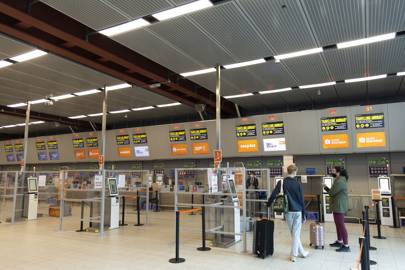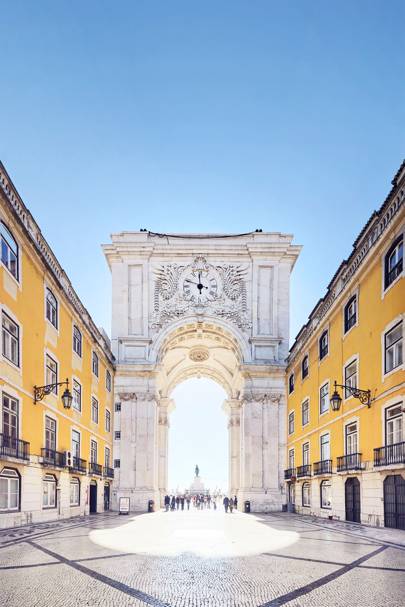The warm air as you exit the airport, a gentle breeze on the taxi to the hotel, a freshly baked pastel de nata outside a small café in the late afternoon – these are some of the things UK residents can experience if they travel to Portugal right now. But is the effort of organising the journey worth it?
As one of many Brits separated from a loved one during the pandemic, getting on one of the first legal flights from London-Luton to Lisbon was a given for me. I had a flight booked since late 2020, which was rescheduled multiple times, and as soon as it was announced on Friday 7 May that Portugal would be given green list status I began preparing.
Of course, travel is not what it used to be – getting a spontaneous flight to Europe is impossible, given the 72-hour window you have to book a PCR test – but I was willing to do whatever it took. Here’s what to expect if you’re also planning a trip to Portugal this summer.
PRE-FLIGHT
After some bumps in the road waiting for Portugal to confirm that UK residents could visit the country, it was confirmed on Friday 14 May that my trip would be going ahead. Portugal requires visitors to fill out a passenger locator form (as do most countries now), so I added my details, including where I’d be staying and my flight and passport numbers, into the online form. The process was quick and easy, and I was immediately emailed a QR code to show at the airport.
Next on the agenda was booking a PCR fit-to-fly test. Many flight operators now offer this service at a more affordable price (EasyJet, for example, has a deal with Randox to allow passengers to book a test for £60), and these often come in the post. Results are promised within 24 hours of receipt, but I chose to go to a nearby clinic in case of postal delays – after seven rescheduled flights, I wasn’t going to take any chances. I paid £80, which was more than the cost of my return flight, but it was quick and easy: the staff who swabbed me explained everything clearly, and I received my negative result within 24 hours.
READ NEXT
- Can I go to Italy? The rules for travelling to the amber list country
TRAVEL TIPSCan I go to Italy? The rules for travelling to the amber list country
AT THE AIRPORT
The airport process has changed a lot. But this isn’t necessarily a bad thing – it was actually far easier than I was anticipating after seeing reports of people queueing for hours at check-in and security. In reality, check-in took no longer than usual, despite airline staff looking at our test certificates and locator forms. Security was a smooth process too, although the airport was far quieter than I’d ever seen it. Perhaps in high summer, with more people travelling, the socially distanced queue would feel like it stretched for miles, but I managed to get through to the departure lounge within 30 minutes.
Masks must be worn at all times in the airport, and most of the shops were closed – although I was able to pick up some necessities in Boots and WH Smith.

Boarding the flight was probably the most difficult part of the airport experience: it’s almost impossible to socially distance yourself in a queue of more than 100 people. However, the knowledge that everyone had recently had a negative test result was reassuring, and airline staff were as efficient as possible completing the checks necessary to board.
LANDING
After a quick – albeit almost full – flight, we landed in Lisbon and were directed to a separate queue. This was my first flight post-Brexit, so I wasn’t sure what to expect in terms of queues, but again I think the reduced capacity worked in my favour here. I was asked what the purpose of my visit was, and how long I’d be staying, before being allowed through to baggage claim. The whole process took around 20 minutes, and if you’ve ever crossed a land border in South-east Asia or South America it will feel like a doddle by comparison.
IN PORTUGAL
So, what’s it like in Portugal? Well… it’s hot. Regarding the Covid situation, restaurants and bars are open with limited group numbers (although with a 10.30pm curfew), and daily cases are currently lower than in many other European countries. Masks are worn at all times here, though – even outdoors – which can be sweaty when you’re climbing up Lisbon’s hills.

Whether I’d recommend travelling to other people depends very much. For me, coming here was a no-brainer and I have zero regrets. But shouldering the cost of tests, and dealing with the uncertainty before flying, was a burden I wouldn’t wish on anyone.
Before this trip I’d never considered myself an anxious traveller. I lived in Australia for two years, always going back and forth between there and home, and I have taken redirected flights and unscheduled stopovers in my stride. But never have I felt so nervous about so many different factors, and even during my time here I’m having to keep an eye on things back home to make sure my return journey will be fine. Having said that, there’s no feeling like being in a new city, and if you’re also someone who lives for your next trip, being able to go exploring again makes it all feel worth it.
Source: cntraveller.com



 TRAVEL TIPSCan I go to Italy? The rules for travelling to the amber list country
TRAVEL TIPSCan I go to Italy? The rules for travelling to the amber list country
























